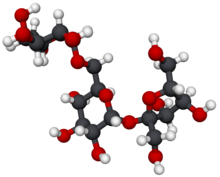Raffinose
This article needs additional citations for verification. (April 2015) |

| |

| |
| Names | |
|---|---|
| Preferred IUPAC name
(2R,3R,4S,5S,6R)-2-{[(2S,3S,4S,5R)-3,4-Dihydroxy-2,5-bis(hydroxymethyl)oxolan-2-yl]oxy}-6-({[(2S,3R,4S,5R,6R)-3,4,5-trihydroxy-6-(hydroxymethyl)oxan-2-yl]oxy}methyl)oxane-3,4,5-triol | |
| Other names
rafinosa
D-(+)-Raffinose D-Raffinose D-raffinose pentahydrate Gossypose Melitose Melitriose NSC 170228 NSC 2025 6G-α-D-galactosylsucrose; β-D-fructofuranosyl-O-α-D-glucopyranosyl-(1→6)-α-D-galactopyranoside hydrate(1:5) | |
| Identifiers | |
| |
3D model (JSmol)
|
|
| ChEBI | |
| ChemSpider | |
| ECHA InfoCard | 100.007.407 |
| EC Number |
|
PubChem CID
|
|
| UNII | |
CompTox Dashboard (EPA)
|
|
| Properties | |
| C18H32O16 | |
| Molar mass | 594.5 g/mol (pentahydrate) |
| Melting point | 118 °C |
| 203 g/L | |
Except where otherwise noted, data are given for materials in their standard state (at 25 °C [77 °F], 100 kPa). | |
| Infobox references | |
Raffinose is a trisaccharide composed of galactose, glucose, and fructose. It can be found in beans, cabbage, brussels sprouts, broccoli, asparagus, other vegetables, and whole grains. Raffinose can be hydrolyzed to D-galactose and sucrose by the enzyme α-galactosidase (α-GAL), an enzyme not found in the human digestive tract. α-GAL also hydrolyzes other such as stachyose, , and , if present. The enzyme does not cleave β-linked galactose, as in lactose.
Chemical properties[]
The raffinose family of oligosaccharides (RFOs) are alpha-galactosyl derivatives of sucrose, and the most common are the trisaccharide raffinose, the tetrasaccharide stachyose, and the pentasaccharide verbascose. RFOs are almost ubiquitous in the plant kingdom, being found in a large variety of seeds from many different families, and they rank second only to sucrose in abundance as .
Raffinose may have a form of a white crystalline powder. It is odorless and has a sweet taste approximately 10% that of sucrose.[1]
Biochemical properties[]
Energy source[]
It is non-digestible in humans and other monogastric animals (pigs and poultry) who do not possess the α-GAL enzyme to break down RFOs. These oligosaccharides pass undigested through the stomach and small intestine. In the large intestine, they are fermented by bacteria that do possess the α-GAL enzyme and make short-chain fatty acids (SCFA)(acetic, propionic, butyric acids), as well as the flatulence commonly associated with eating beans and other vegetables. These SCFAs have been recently found to impart a number of health benefits. α-GAL is present in digestive aids such as the product Beano.
Disease relevance[]
Research has shown that the differential ability to utilize raffinose by strains of the bacteria Streptococcus pneumoniae, impacts their ability to cause disease.[2]
Uses[]
Procedures concerning cryopreservation have used raffinose to provide hypertonicity for cell desiccation prior to freezing.[3] Either raffinose or sucrose is used as a base substance for sucralose.
Raffinose is also used in:[1]
- skin moisturizers and smoothers
- prebiotics (it allegedly promotes growth of lactobacilli and bifidobacteria)[4]
- food or drinks additive
See also[]
Further reading[]
References[]
- ^ Jump up to: a b "D(+)-Raffinose pentahydrate | 17629-30-0". www.chemicalbook.com. Retrieved 2019-08-19.
- ^ Minhas, Vikrant; Harvey, Richard M.; McAllister, Lauren J.; Seemann, Torsten; Syme, Anna E.; Baines, Sarah L.; Paton, James C.; Trappetti, Claudia (2019-01-15). McDaniel, Larry S. (ed.). "Capacity To Utilize Raffinose Dictates Pneumococcal Disease Phenotype". mBio. 10 (1). doi:10.1128/mBio.02596-18. ISSN 2150-7511.
- ^ Storey B., Noiles, E., Thompson, K. (1998). "Comparison of Glycerol, Other Polyols, Trehalose, and Raffinose to Provide a Defined Cryoprotectant Medium for Mouse Sperm Cryopreservation". Cryobiology. 37 (1): 46–58. doi:10.1006/cryo.1998.2097. PMID 9698429.CS1 maint: multiple names: authors list (link)
- ^ Zartl B, Silberbauer K, Loeppert R, Viernstein H, Praznik W, Mueller M. Fermentation of non-digestible raffinose family oligosaccharides and galactomannans by probiotics. Food Funct. 2018 Mar 1;9(3):1638-1646. doi: 10.1039/c7fo01887h. Epub 2018 Feb 21. PMID: 29465
- Trisaccharides